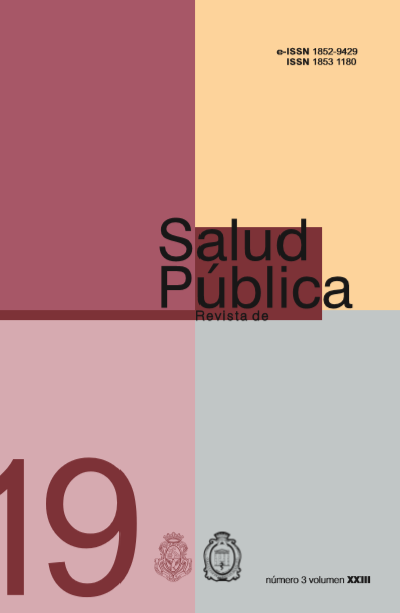CLINICAL CHARACTERISTICS OF PEOPLE DEPRIVED OF FREEDOM WITH SEXUALLY TRANSMITTED INFECTIONS IN BAHIA BLANCA.
DOI:
https://doi.org/10.31052/1853.1180.v23.n3.23509Keywords:
Health profile, Prisons, Sexually Transmitted Infections, Public HealthAbstract
In Argentina, there is no information regarding the situation of Sexually Transmitted Infections (STIs) in prisons in the country. After six years of university extension work to train health promoters in a prison in Bahia Blanca, we observed that STIs is a topic of great interest among people deprived of freedom. Objective: To describe clinical characteristics of people deprived of freedom with STIs in the prison of Bahia Blanca, Buenos Aires, Argentina, during 2017. Methods: Descriptive cross-sectional study. Medical histories and the following variables were analyzed: sex, age, nationality, occupation, education, date and reason of consultation, diagnosis of STI and treatment. A description was done including absolute and relative frequencies, centrality measures, dispersion and graphics. Results: Prisonpopulation of 672 people (96.4 % male); 2.3% has a STI. The most frequent diagnosis was HIV, followed by syphilis with 18.7% and Hepatitis C with 6.2%. Conclusion: This work intends to be a contribution to STI research in Argentinian prisons. The
description of the situation of STIs would allow promotion and intervention strategies.
Downloads
References
1.Oficina de las Naciones Unidas contra las Drogas y el Delito. El VIH y el sida en los lugares de detención. [Internet] 2012. Citado el 10 de febrero de 2018. Disponible en: https://www.unodc.org/documents/lpobrazil/Topics_aids/Publicacoes/toolkit_spanish_completed.pdf
2. Organización de las Naciones Unidas SIDA. Prevención, tratamiento y atención del VIH en las cárceles y otros lugares de reclusión: conjunto completo de intervenciones. [Internet] 2013. Citado el 10 de febrero de 2018. Disponible en: http://www.unaids.org/es
3. European Centre for Disease Prevention and Control. Thematic report: Prisoners. Monitoring implementation of the Dublin Declaration on Partnership to Fight HIV/AIDS in Europe and Central Asia: 2014 progress report. [Internet] 2015. Citado el 15 de febrero de 2018. Disponible en: https://ecdc.europa.eu/sites/portal/files/media/en/publications/Publications/dublin-declaration-prisoners-2014.pdf
4.Marco A, Saiz de la Hoya P, García Guerrero J y Grupo PREVALHEP. Estudio Multicéntrico de Prevalencia de Infección por el VIH y factores asociados en las prisiones de España. Rev Esp Sanid Penit [Internet] 2012; 14: 17-24. Citado el 14 de noviembre de 2016. Disponible en http://scielo.isciii.es/pdf/sanipe/v14n1/en_04_original3.pdf
5. Sánchez-Recio R, Alonso-Pérez de Ágredab J P y Santabárbara-Serranob J. Infecciones de transmisión sexual en hombres internos en prisión: riesgo de desarrollo de nuevas infecciones. Gac Sanit. [Internet]. 2016;30(3):208–214. Citado el 1 de febrero de 2018. Disponible en: http://dev.gacetasanitaria.elsevier.es/es/infecciones-transmision-sexual-hombres-internos/articulo/S0213911116000194/
6. Garriga C., Gómez-Pintado P., Díez M., Acín E., Díaz A. Características de los casos de sífilis infecciosa diagnosticados en Instituciones Penitenciarias, 2007-2008. Rev. esp. sanid. penit. [Internet]. 2011 [citado 2018 feb 18] ;13(2): 52-57. Disponible en: http://scielo.isciii.es/scielo.php?script=sci_arttext&pid=S1575-06202011000200004&lng=es.
7. Dirección de SIDA y Enfermedades de Transmisión sexual. Estudio de prevalencia de VIH, sífilis, hepatitis virales y tuberculosis en personas en contexto de encierro en unidades del Servicio Penitenciario Federal. [Internet] 2017. Citado el 10 de noviembre de 2017. Disponible en: http://www.msal.gob.ar/images/stories/bes/graficos/0000001084cnt-2017-12-29_carceles-vih.pdf
8. Grunfeld-Baeza M V, Palomo D M, Arnaudo M C, Arena M C, D'Annuncio V, Troccoli M. Formar promotores de salud en contextos penitenciarios: una experiencia de la labor extensionista universitaria. Edumecentro [Internet]. 2018 Mar; 10( 1 ): 1-17. Citado 10 de mayo de 2018 Disponible en : http://scielo.sld.cu/scielo.php?script=sci_arttext&pid=S2077-28742018000100001&lng=pt.
9. Municipalidad de Bahía Blanca [Pagina web], citada el 21 de febrero de 2018. Disponible en: http://www.bahiablanca.gob.ar/equipos-de-trabajo/salud 2015/nomenclador-del-trabajador-en-salud-en-el-pna/
10. Global Family Doctor (WONCA), International Classification of Primary Care. [Internet] 2016. Citado el 30 de mayo de 2018. Disponible en: https://cutt.ly/Ne3MIWO
11 Ministerio de Salud de la Nación. VIH-sida en privación de la libertad: respuesta preventivo-asistencial de la Dirección Nacional del Sida y ITS. (S/F) [Internet] Citado el 10 de noviembre de 2017. Disponible en: http://www.msal.gob.ar/images/stories/bes/graficos/0000000328cnt-2014-01_vih-contextos-encierro.pdf
12. Posada A., Díaz Tremarias M. Infección por VIH, Hepatitis B y Sífilis en reclusos de centros penitenciarios de Venezuela, 1998-2001. Rev. esp. sanid. penit. [Internet]. 2008 [citado 2018 Mar 11] ; 10(3): 73-79. Disponible en: http://scielo.isciii.es/scielo.php?script=sci_arttext&pid=S1575-06202008000300003&lng=es.
Downloads
Published
Issue
Section
License
Copyright (c) 2019 Escuela de Salud Pública y Ambiente. Facultad de Ciencias Médicas. Universidad Nacional de Córdoba

This work is licensed under a Creative Commons Attribution-NonCommercial 4.0 International License.
Authors who publish with this journal agree to the following terms:
- Authors retain copyright and grant the journal right of first publication with the work simultaneously licensed under a Creative Commons Attribution License which allows the work to be copied, distributed, exhibited and interpreted as long as it is not done for commercial purposes.
- Authors are able to enter into separate, additional contractual arrangements for the non-exclusive distribution of the journal's published version of the work (e.g., post it to an institutional repository or publish it in a book), with an acknowledgement of its initial publication in this journal.
- Authors are permitted and encouraged to post their work online (e.g., in institutional repositories or on their website) after the publication process. (See The Effect of Open Access). (See The Effect of Open Access).







